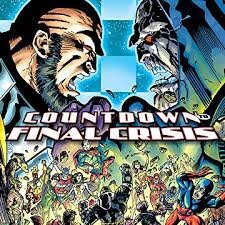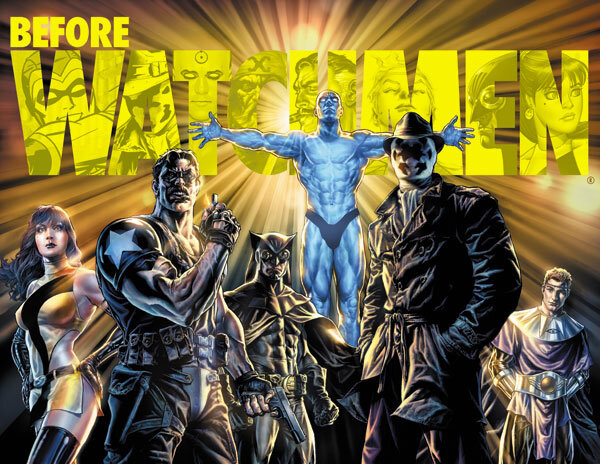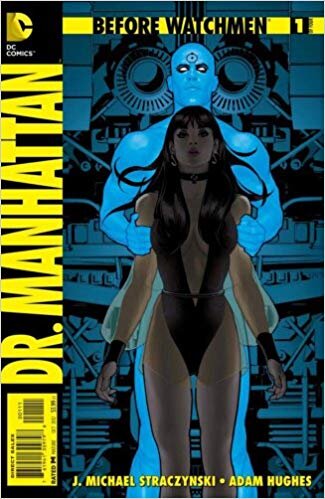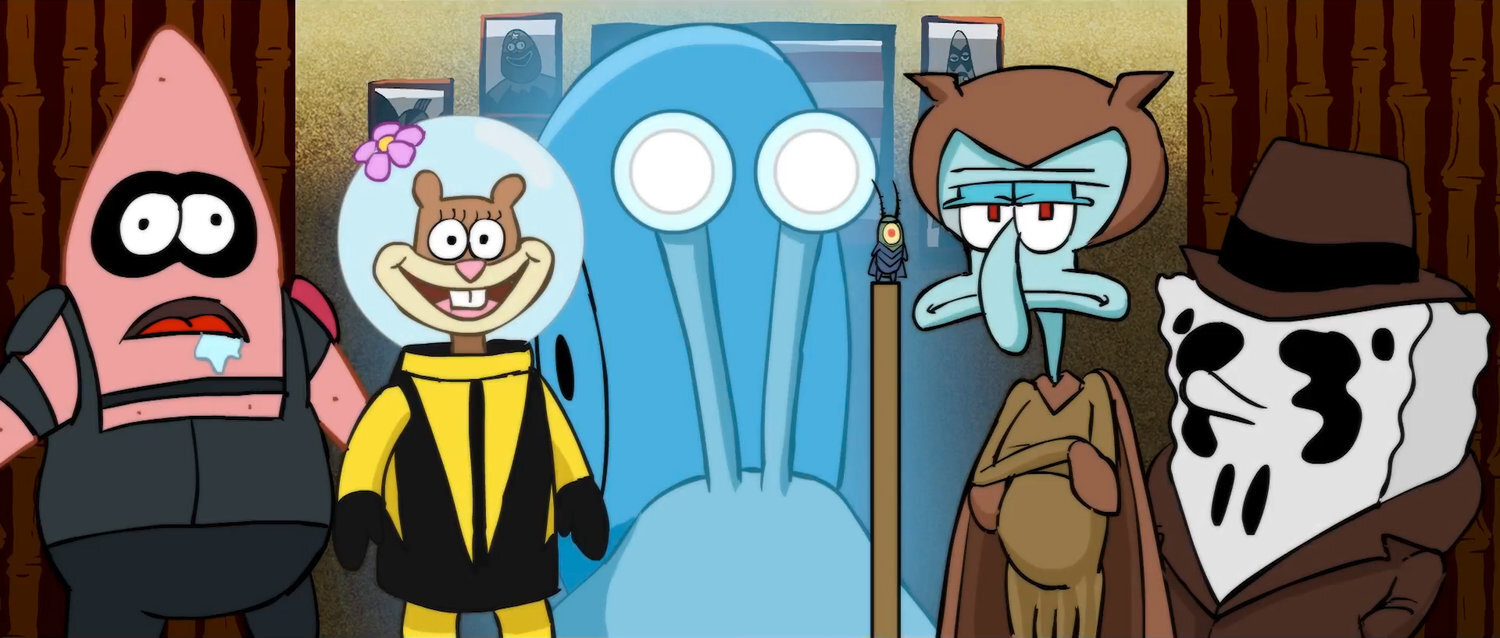Before Watchmen: Corporate Fan Fiction
“I don’t want money. What I want is for this not to happen.”
For nearly two decades, despite all the bad blood between Alan Moore and his former publisher, DC comics let the graphic novel Watchmen stand on its own. And why not? The book had sold millions of copies, and continued to be the jewel in DC’s crown.
But that’s not how corporate comics usually works. DC and Marvel are both habitually guilty of wringing every last sales dollar out of a popular idea until it has been reduced to a shadow of its former self. In the 1990s, Marvel started what was intended to be a limited storyline about Spider-Man’s clone, but when it proved to be a best-seller, they dragged it out so long that even Marvel eventually published a parody comic about how convoluted and impossible the story had become. Their crossover series Civil War was a hit, so naturally they did a much less successful Civil War 2. As for DC, even since its continuity-redefining Crisis on Infinite Earths, the company has returned to that particular well long after it ran dry (Zero Hour: Crisis in Time, Infinite Crisis, Final Crisis, and the execrable Countdown to Final Crisis).
COMING SOON: “BEFORE COUNTDOWN TO FINAL CRISIS”
Given this tendency towards self-recycling, the fact that DC waited until 2012 looks like a surprising exercise in self-restraint. Or maybe the higher-ups were following the Mayan calendar, and figured that, with the world ending, all bets were off.
More likely is the explanation widely accepted in the comics community. Until he left his position as president and publisher of DC comics in 2009, DC lifer Paul Levitz held a line in the sand when it came to further exploitation of Watchmen. Given that he was responsible for one of the last incidents to alienate Moore from DC (pulping an issue of The League of Extraordinary Gentlemen), there is something either poetic or ironic about the situation. In any case, with Levitz gone, all bets we’re off.
According to Moore, he and Gibbons had briefly considered prequel materials in the mid-1980s, but decided that there was little point. In 2010, DC offered to give him back the rights to the original Watchmen in exchange for his blessing of new Watchmen material, but Moore turned them down flat. Gibbons issued a lukewarm statement in support of DC, and the company went forward with the project called Before Watchmen.
IT’S 2012. DC COMICS HAS RUN OUT OF IDEAS
Watchmen, let’s recall, was originally a twelve-issue series with a beginning, middle, and an end (ok, given Jon’s fourth-dimensional perspective, also a huge number of flashbacks, digressions, and recursive loops, but still). Upon completion, Before Watchmen was a set of eight limited series and a single one-shot, coming to a grand total of 37 issues.
DC wasn’t just supplementing Watchmen; they were drowning it.
Look on My Works, Ye Mighty. Or Better Yet, Don’t
To be fair, they weren’t doing it on the cheap: DC signed up top-flight creators (including Amanda Conner, Darwin Cooke, J.G. Jones, Jae Lee, and J, Michael Straczynski) to produce the various miniseries. Visually, the choices were very much on-point: Cooke’s cartoonishness for Minutemen, Jae Lee’s arresting, deliberately static set-pieces for Ozymandias, Amanda Conner’s facility with human forms and faces for Silk Spectre.
Yet the willingness of big-name comics artists and writers to work on Before Watchmen was, in itself, disturbing to those who disapproved of the project. In turn, the creators involved got defensive. Straczynski, who made a name for himself in television (Babylon 5) before turning to comics, also brought a television writer’s comfort level with corporate ownership of his creations:
“Did Alan Moore get screwed on his contract? Of course. Lots of people get screwed, but we still have Spider-Man and lots of other heroes.”
Writer Brian Azzarello, tasked with bringing his trademark ultraviolence to Watchmen’s most vicious characters (Comedian, Rorschach), commented: “a lot of comics readers don’t like new things.” Considering Moore’s oft-repeated refrain that DC keeps exploiting even his tiniest ideas because they don’t have their own, Azzarrello’s complaint shows a stunning lack of self-awareness.
Azzarello’s and Straczynski’s views were not universally shared at DC. Chris Roberson, who had been making a name for himself at the company’s adult-themed Vertigo imprint with runs on Fairest and his own co-creation, iZombie (whose television adaptation has just finished its run), publicly denounced the plans for Before Watchmen and declared that he would no longer be working for the company. This, however, is the only such resignation of which I’m aware.
In any case, the finished product of Before Watchmen was…fine, for the most part. While Azzarello’s own contributions were among the weakest (just another excuse to watch antiheroes beat people to a pulp), Cooke’s and Conner’s Silk Spectre is a charming period piece about teenage Laurie Juspeczyk running away to Haight-Ashbury. Len Wein’s and Jae Lee’s Ozymandias is nice to look at, but adds little of interest to the title character’s story (except that he’s bisexual, and even that is handled in a rather mealy-mouthed fashion). Straczynski’s Nite Owl (drawn by the Kubert brothers) is a middle-of-the-road affair, guilty of the “sin” with which Alan Moore keeps tarnishing the last three decades of DC’s output: the plot about Dan Dreiberg’s affair with the dominatrix Twilight Lady is a long, unnecessary expansion of two or three panels from Watchmen (panels that worked just fine on their own).
WHAT THE HELL IS GOING ON IN THIS COVER?
The most original take on the Watchmen characters (if that word is even appropriate) is provided by Straczynski, with art by Adam Hughes, in the Dr. Manhattan miniseries. It is also the most daring. Moore’s approach to Dr. Manhattan, particularly in the Mars chapters, is based on a simultaneous model fo time: all moments that have ever existed are out there in the fourth dimension, and Jon can hop from one to the other without skipping a beat. Straczynski replaces Moore’s temporal mechanics with quantum physics: now we are dealing not just with all moments that every happened, but all moments that could have happened (but didn’t). Straczynski re-writes Moore by trying to out-physics him.
The result is fascinating. Straczynski transposes the famous “Schroedinger’s Cat” thought experiment to Jon’s own life (and death). In the original comic, when Jon’s body is taken apart, molecule by molecule, his friends bury an empty coffin. But in a parallel timeline, Jon simply dies, rather than becoming Dr. Manhattan, leaving behind an ordinary corpse. From his privileged quantum superposition, Dr. Manhattan contemplates Schroedinger’s Coffin.
It’s quite clever. But what does it add to Watchmen? The ministries strengths are the same as its weaknesses: rather than reverently work in the shadow of a classic, Straczynski’s Dr. Manhattan story polemicizes with it, offering an alternative approach that cannot square with the original comic, but is intriguing on its own. So what is it for?
What Is an Author?
The status of Before Watchmen cannot be disentangled from the complications of Watchmen’s authorship. On the one hand, we know who wrote, drew, colored, and lettered the comic. In other words, we know who created it. But with DC/Time Warner as the legal owner of the property, they reserve for themselves the most important rights implicit in the very word “author”: legal authority that allows them to authorize additional exploitation of Watchmen.
When a popular story or franchise is continued, revised, or otherwise reworked by people who are not the text’s authors, we have a simple term: fan fiction. Fan fiction (fic) can have a vexed status when the rightsholders are particularly litigious, and writers for ongoing television properties are often discouraged from reading fic in order to shield them from claims that they have stolen ideas from fan fiction.
There is only one thing that truly differentiates Before Watchmen from fan fiction: it is the product of Watchmen’s legal owners. Otherwise, we are faced with artistic products created against the express wishes of one of Watchmen's two primary creators.
Before Watchmen is corporate fan fiction.
My point is not to denigrate fan fiction, one of the few artistic phenomena that is disdained and dismissed even more often than superhero comics. Like any other fiction, fic ranges in quality from the horrible to the sublime. But it serves a variety of purposes that professionally published fiction usually does not.
Fan fiction rejects the very notion of the passive reader, encoring communities of readers to take control of their beloved narratives for their own purposes. Fan fiction can be a training ground for future professionals, a creative outlet for hobbyists, or a chance to include marginalized voices in versions of a mainstream narrative. Or, setting all that aside, it can simply be harmless fun.
ADMIT YOU LOVE THIS, YOU SNOBS
But there is nothing liberating, empowering, or even fun about a corporation hiring professionals to expand a fictional universe its creators consider closed. There is no thrill of transgression and few flashes of novelty. Before Watchmen does not celebrate the original authors though homage or pastiche. It is an exercise in raw power, a thirty-seven-issue argument that Time Warner matters, and Alan Moore does not.
Comments (2)
Anders Davenport 6 months ago · 0 Likes
“Chris Roberson, who had been making a name for himself at the company’s adult-themed Vertigo imprint with runs on Fairest and his own co-creation, iZombie (whose television adaptation has just finished its run), publicly denounced the plans for Before Watchmen and declared that he would no longer be working for the company.”
I didn’t know that about Chris Roberson. It must take a lot of guts to publicly do and say something like that as a matter of principle. I’m curious as to what he ended up doing after that; iZombie was a fun read with gorgeous Michael Allred art.
You’re very kind to Straczynski’s Doctor Manhattan story, but my memories of that one in particular were that it read like really bad fan fiction, like childishly bad. But to each his own.
This whole article is very well written. You make a very good point about fan fiction in general, as well as how Before Watchmen roughly rises to the level of “corporate fan fiction.” That’s the perfect term.
John C 10 months ago · 0 Likes
“Watchmen, let’s recall, was originally a twelve-issue series with a beginning, middle, and an end...”
Nothing ends, Adrian. Nothing ever ends.



